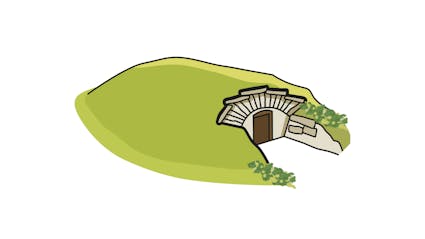514 – Cabbage cellar from Oberschrot Fribourg, 19th Century
The cellar from Oberschrot is an architectural oddity on the Ballenberg. As simple as it may seem as a construction, it was extremely important as a predecessor of the deep freeze.

A rare bird
Stalls, houses alpine huts, smithies, inns, chapels, kiosks, villas – the 110 buildings in the Ballenberg Open Air Museum all have some common features: roofs and windows. All? The cistern (112), the grain drying racks (892) and this cabbage cellar from Oberschrot are architectural oddities. As simple as these buildings may appear, they had important tasks to fulfill. No water, no life; no grain, no bread. And how about cabbage?

Winter reserves
The farmstead “im Bifang” (the Forks) lies in the hamlet of Oberschrot, ten kilometres (6 miles) away from the city of Fribourg and belongs to the neighbouring parish of Plaffeien. The little cellar under the house couldn’t accommodate the entire harvest. Dig a trench, erect a stone barrel vault over it and cover it in with earth – there you have an underground room four metres long with a vault height of one metre thirty (thirteen feet by four). The lack of storage space is remedied. Such a cellar has the ideal climate for storing cabbage and other vegetables. Fruit can be stored in modest wooden racks, vitamin-rich food for the long winter months. After the main house, the granary and the bake house, a cabbage cellar is the fourth element of a typical farmstead in the Sense valley region. In Switzerland, this kind of cellar is only found in the territory around Fribourg.

Predecessors of the deep
Freezer Grain could be stored long term in a granary. Meat could be hung in smoke to preserve it. Fruit and vegetables could be dried in drying ovens or in the bake house. Leeks could be kept fresh for months buried in sand in the cellar of the main house. Milk products could be stored in the cool spring house. Chestnuts had their own drying houses – necessity is the mother of invention, especially in keeping life-giving food.
Ballenberg
Swiss Open-Air Museum
Museumsstrasse 100
CH-3858 Hofstetten bei Brienz
Company holidays
24 December 2025 to 11 January 2026
Opening hours Administration
3 November 2025 to 8 April 2026
From Monday to Friday
8.30 am to 11.30 am
1.30 pm to 4.30 pm
Opening hours
9 April to 1 November 2026
10 am to 5 pm daily